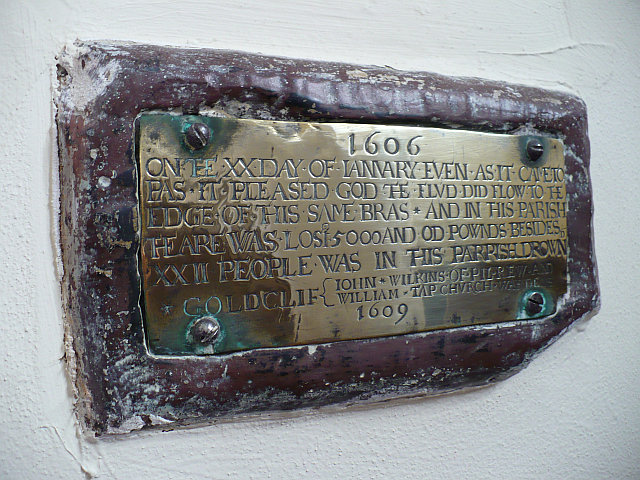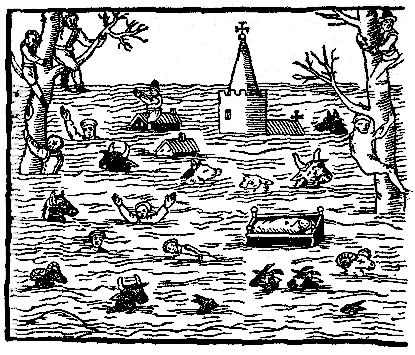Storm Event
It came so fiercely, that it was hard for a man or beast to escape by flight
Source
According to eyewitness accounts of the weather, the storm surge appears to have been due to gale force westerly or south-westerly winds (Horsburgh and Horritt, 2007). There was previously a theory that the storm surge was a tsunami (Bryant and Haslett, 2002). This theory was based heavily on inferences from historical erosion of wetlands; and the significant volumes of water and massive coastal damage that can be caused by storm surges were underestimated (Horsburgh and Horritt, 2007). However, Horsburgh and Horritt (2007) used numerical modelling to confirm that the exceptionally high tide, combined with a storm surge from this eyewitness weather, is capable of producing the flooding that occurred. In addition, areas of the eastern side of the UK also flooded on the same day, although in the evening (Horsburgh and Horritt, 2007), consistent with storm surge behaviour but not tsunamis. There is no information on waves generated. The only indication of the height of the storm surge is from the historic indicators listed below.
Pathway
It was reported that the flood reached a speed of 48 km hr-1 and 7.6 m high; extending 6.4 km inland in north Devon, Pembrokeshire, Glamorgan, Monmouthshire and Cardiff; and up to 22.5 km in low-lying parts of Somerset (BBC, 2007). The storm surge breaches the sea wall and Burnham on Sea and Kingston Seymour, Somerset, breaking the sea wall in the latter location (Somerset Guide, 2009; Brooks and Glasspoole, 1928).

Flood plaque, in St Mary’s Church, Goldcliff, near Newport -https://en.wikipedia.org/wiki/Bristol_Channel_floods,_1607
Receptor and Consequence
This storm surge resulted in widespread and severe coastal flooding throughout southern Wales, and Devon and Somerset in England. It is estimated that 520 km2of land was flooded (BBC, 2007).The effects were felt on the east coast of the UK, with reports of flooding as far as Norfolk (Stow, 1631; Hickey, 1997). At Burnham on Sea, the storm surge broke over the sea wall and flooded 30 villages; and the surrounding countryside was flooded with 3 to 2.7 m of water (Somerset Guide, 2009). A church in Kingstone Seymour was flooded to a depth of 5 ft, the water barely receded for 10 days (Brooks and Glasspoole, 1928). Stow (1631) reports that £20,000 worth of damage was done to 20 towns in Somerset. Monmouth, it was reported that a milkmaid was rescued from drowning by ‘two lustie strong men’ who made a boat from a water trough (Whipple, 2011).
There are several indicators showing the maximum height of the water, including a chisel mark at Church of All Saints at Kingston Seymour, Somerset, that was filled with 1.5 m of water (7.74 m above sea level (Hawkins, 1982). There are several churches with commemorative plaques, perhaps the most famous of which is Marys Church at Goldcliff, Wales, where it is about 0.9 m above ground; and 7.14 m above Ordinance Datum (Williams, 1970). This plaque states: ‘On the XX day of Ianuary even as it came to pas it pleased God the flvd did flow to the edge of this same bras and in this parish theare was lost 5000 and od pounds besides XXII people was in this parrish drown’ (WalesOnline, 2013).

Contemporary depiction of the 1607 flood. The church is thought to be St Mary’s at Nash, near Newport. Source: https://en.wikipedia.org/wiki/Bristol_Channel_floods,_1607
Summary Table
| Loss of life | 2000 deaths |
| Residential property | 30 villages at Burnham on Sea when storm surge reached over the sea wall |
| Evacuation & Rescue | A milkmaid rescued from drowning in Monmouth |
| Cost | * |
| Ports | * |
| Transport | * |
| Energy | * |
| Public services | * |
| Water & wastewater | * |
| Livestock | A woodcut image depicts loss of farmland, with livestock caught in the flood (printed in London by W. I. for Edward White) |
| Agricultural land | Above woodcut image suggests flooded farmland. Estimated that 520 km2 of land was flooded |
| Coastal erosion | * |
| Natural environment | * |
| Cultural heritage | * |
| Coastal defences | Burnham on Sea flooded was due to storm overtopping the sea wall |
*No known sources of information available
Quotes:
“The floods extended along the coast for some twenty miles, and in some places the water reached a depth of 12 feet” –Brooks and Glasspoole, 1928
“Some places the water overflowed their bankes three foote, in some places five foote, and in some places almost eight foote” – Stow, 1631
“It came so fiercely, that it was hard for a man or beast to escape by flight” – Stow, 1631
We rely on submissions from the public to maintain these images. If you witnessed this event, please help by uploading your photos.
References
- Horsburgh, K. and Horritt, M. (2007). ‘The Bristol Channel floods of 1607 – reconstruction and analysis’. Weather 61(10)
- Bryant, E. A. and Haslett, S. K. (2002). ‘Was the AD1607 coastal flooding event in the Severn Estuary and Bristol Channel (UK) due to a tsunami?’ Archaeology in the Severn Estuary (13) 163–167.
- Horsburgh, K. and Horritt, M. (2007). ‘The Bristol Channel floods of 1607 – reconstruction and analysis’. Weather 61(10)
- BBC (2007). ‘The great flood of 1607’. BBC News. Available at: http://www.bbc.co.uk/bristol/content/articles/2007/01/30/flood_feature.shtml (Accessed: 22 November 2016).
- Somerset Guide. (2009). Burnham on Sea. Available at: http://www.somersetguide.co.uk/Burnham-on-Sea (Accessed: 21 August 2014).
- Brooks, C. E. P. and Glasspoole, J. (1928). British Floods and Droughts. London: Ernest Benn, 199pp.
- Stow, J. (1631). Annales, or a generall chronicle of England: begun first by Maister John Stow, and after him continues and augmented with matter forreyne, and domestique, ancient and modern, into the ende of his present yeere 1614. Londini: Impensis T. Adams, 1615
- Hickey, K. R. (1997). Documentary records of coastal storms in Scotland, 1500-1991 A.D. Coventry University. Available at: https://curve.coventry.ac.uk/open/file/aa6dfd04-d53f-4741-1bb7-bdf99fb153be/1/hick1comb.pdf.
- Brooks, C. E. P. and Glasspoole, J. (1928). British Floods and Droughts.London: Ernest Benn, 199pp.
- Stow, J. (1631). Annales, or a generall chronicle of England: begun first by Maister John Stow, and after him continues and augmented with matter forreyne, and domestique, ancient and modern, into the ende of his present yeere 1614. Londini: Impensis T. Adams, 1615
- Whipple, T. (2011). Britain’s tsunami: ‘It will happen at some point’. The Times. Available at: http://www.thetimes.co.uk/tto/life/article2948730.ece (Accessed: 22 November 2016),
- Hawkins, D. (1982). Avalon and Sedgemoor. pp. 29–30. ISBN 0-86299-016-5.
- Williams, M. (1970). The draining of the Somerset Levels. Cambridge University Press.
- WalesOnline, 2013. Was the great flood of 1607 Britain’s tsunami? 3 November 2013. Available at: http://www.walesonline.co.uk/news/wales-news/great-flood-1607-britains-tsunami-6265764 (Accessed: 22 November 2016).

